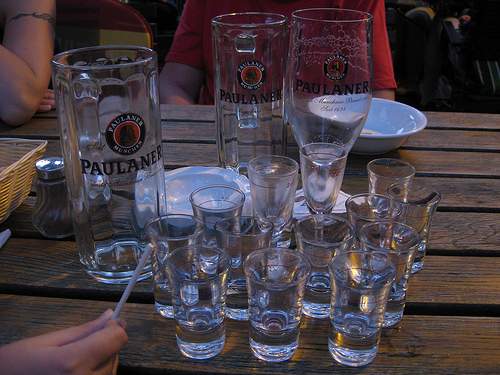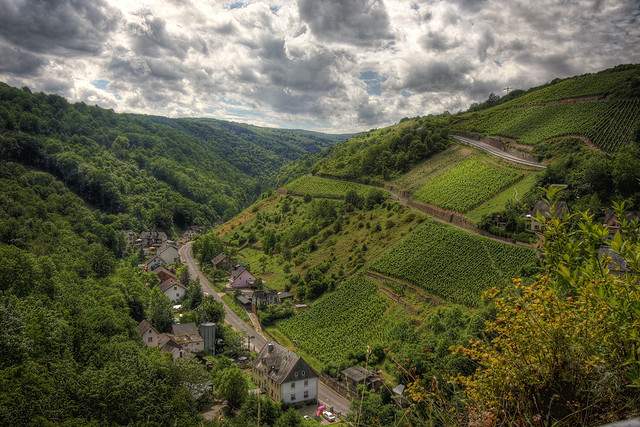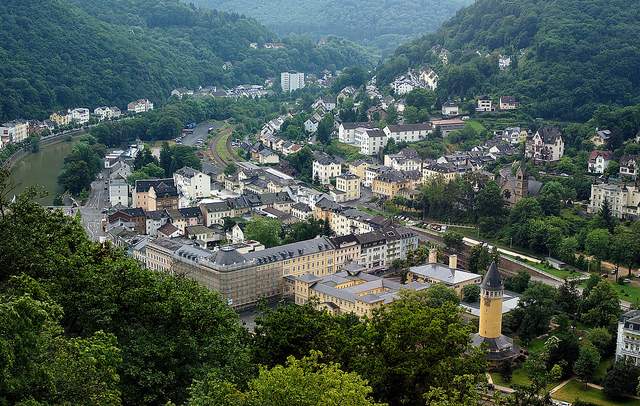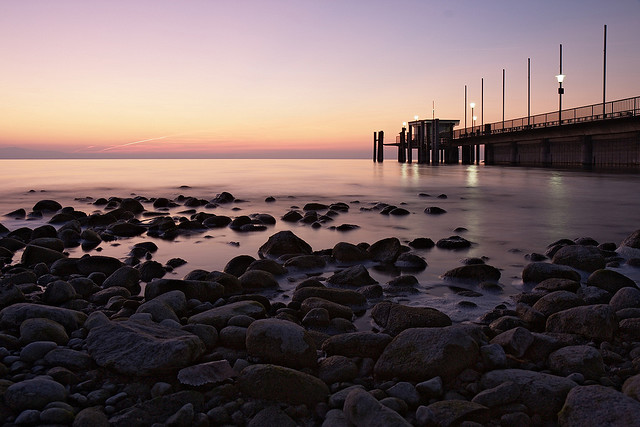Ask someone on the street which alcoholic drink they associate with Germany and nine out of ten times you will get one answer: beer. However, Germany has more to offer than this. Take a trip to the western side along the River Rhine and you will find some of the finest Riesling producing vineyards, with some going back to the Roman era. If you are up for something stronger, take a peek inside old distilleries in the Emsland, a district in lower Saxony. Still like your beer? Then maybe it’s time to try out one of the oldest beer styles, the so called “Weizenbier” and why not along Lake Constance, the third largest in Central Europe.
Riesling in the Rhine Valley
In Germany the Riesling grape has the same status as the Pinot Noir and Chardonnay grapes of Burgundy and the Cabernet Sauvignon of Bordeaux, and produces some of the finest wines that vary in style from light to heavy in weight to sweet and dry in taste. Known for its purity and fresh flowery aroma, the grape has been in the Rhine area from as early as 1435 when Klaus Kleinfisch sold the Count at Ruesselheim six vines of Riesling for 22 soldi.
 Riesling is put into six categories, depending on its alcohol and sugar level: Kabinett, Spätlese, Auslese, Beerenauslese, Eiswein (ice wine) and Trockenbeerenauslese. The ice wine (German: Eiswein) is a dessert wine which is produced from grapes that are only picked after the outside temperature hits below – 7C°; allowing the grapes to release some of their water content, leaving the sugar in a high concentration behind and providing the perfect base for a sweat-alcoholic treat after a good meal.
Riesling is put into six categories, depending on its alcohol and sugar level: Kabinett, Spätlese, Auslese, Beerenauslese, Eiswein (ice wine) and Trockenbeerenauslese. The ice wine (German: Eiswein) is a dessert wine which is produced from grapes that are only picked after the outside temperature hits below – 7C°; allowing the grapes to release some of their water content, leaving the sugar in a high concentration behind and providing the perfect base for a sweat-alcoholic treat after a good meal.
To taste Reisling at local wineries, head to the Rhine Valley, the region along the middle and lower part of the River Rhine, which is one of the longest rivers in Europe at 766 miles. It originates in the Swiss Alps and runs through Switzerland, Lichtenstein, Austria, Germany, France and the Netherlands before flowing into the North Sea at Rotterdam. In Germany, the Rhine valley area offers offers a diverse landscape including low mountain ranges, grassland, marsh area and swamps, making it a paradise for hikers and nature explorers.
Not surprising for a landscape of vineyards and forested hillsides, common menu items include game specialties such as boar and deer, along with locally grown chestnut, peaches and almonds. Other meals that make your mouth water and comfort your stomach are weisskohlrouladen, white cabbage stuffed with minced and deliciously spiced meat, and zwiebelkuchen or flammkuchen, a crossing between a crusted pie and quiche prepared with steamed onions, diced bacon and cream topped on yeast dough, looking like a pizza. In the north of the valley close to the buzzing culture centre of Cologne, you find dishes like reibekuchen, a potato fritter served with apple puree, dicke bohnen mit speck, thick beans with bacon or the very popular “sauerbraten, beef marinated in a sour sweet gravy that falls apart fiber after fiber and dissolves in your mouth, often served with potato dumplings and red cabbage.
Once your stomach is filled with the cuisine of the Rhineland and the last crumble is flushed down with some refreshing Riesling, you can hit the road to explore the countryside by any means; jump on a motor bike with Middle Rhine Tours Ltd, making your way directly from Dover-Calais to the Rhineland and its historical gems, such as the Reichsberg Castle. If you prefer an adventure by foot, tighten your bootlaces and head to the Pfälzerwald, a UNESCO biosphere reserve that presents you with the largest interconnected woodland in Germany, crossed with around 12000km of well signposted hiking paths. To finish your day, stop by in Cologne to enjoy the buzzing nightlife and be stunned by Cologne Cathedral; a Roman church that in 1880-1884 was the tallest structure in the world and is now a World Heritage Site.
>> Read about the cheapest destinations for wine tasting
Schnapps in the Ems valley (German: Emsland)
Schnapps is a German variety of internationally known brandy that branches out into two main categories: Obstler and Korn, which are named after their main ingredient: grain (German: Korn) and fruit (German: Obst). The tradition of producing the pleasurable droplets started in Germany with the introduction of distillation, using resources that were present in large quantities (grain) or passed their expiration date for consumption, such as rotten fruits fallen from the tree.
 The most popular one of the two in Germany is Korn; only deserving the name when reaching an alcohol content of 32% and produced out of buckwheat, oat, wheat, barley or rye. Wheat as ingredient results in a mild distillate in comparison to the strong and aromatic spirit produced by the use of rye. In the Ems valley the mix of apple juice and Korn went down so well that 1976 Berentzen, one of the three biggest distilleries in the region, cheered their folks with the invention of Apfelkorn (apple grain). It took them two years to find the perfect mix.
The most popular one of the two in Germany is Korn; only deserving the name when reaching an alcohol content of 32% and produced out of buckwheat, oat, wheat, barley or rye. Wheat as ingredient results in a mild distillate in comparison to the strong and aromatic spirit produced by the use of rye. In the Ems valley the mix of apple juice and Korn went down so well that 1976 Berentzen, one of the three biggest distilleries in the region, cheered their folks with the invention of Apfelkorn (apple grain). It took them two years to find the perfect mix.
The Ems valley is named after the river Ems, which rises on the south slope of the Teutoburger Forest and flows north and north-west through North-Rhine Westphalia and Lower Saxony. The landscape is shaped by its vast moorland, providing a beautiful display of fauna and flora. Though the area presented challenges to early settlers, with time small villages found their home in the region, using the moor for their own benefit by producing turf until today. The Ems valley is may be not unique in their cuisine but make up for it for providing quality resources which are exported all over the world such as potatoes and free-range meat.
Hire a horse from one of the farms in Meppen and follow the riding tracks towards Haselünne, a little village located at the river Hase, approximately 15km away. There you can relax and enjoy the view of the natural reserve Wacholderhain. Or rent a bike in Meppen for as less than 5 EUR per day (more information under Meppen-Touristeninformation).
Want to know more about schnapps? Visit the Berentzen Distillery that started the production with its establishment in 1758. If you prefer to drink it, check out the events calendar of the Ems valley and try to time your visit with a shootings fair; a competition of shooting a wooden eagle, often accompanied by a three to four day celebration, that also features plenty of schnapps and beer. The folks in the valley are warm-hearted and very welcoming, most properly inviting you to sit down at one of their tables once you introduce yourself.
>> Discover other local drinks (other than beer and wine) to sample around the world
Weizenbier along Lake Constance
Some call it Weizenbier, some Hefeweizen or Weizen and still some others give it the name Weissbier; the difference in names depending on where you order it. Either way, you’ll receive a top-fermented beer, described as spicy and yeasty in flavor with differing hints of fruit, banana or flower.
 In southern Germany it is commonly known as Hefeweizen, referring to its main ingredients yeast and wheat. The term Weissbier comes with a history dating back to the Middle Ages: When Germanic tribes began to brew much paler than usual ales when using wheat and barley, the result yielded in a lighter version of beer than the traditional one, hence the introduction of the name “white beer” (German: Weiss). Hefeweizen differs from other beers in the percentage of wheat that is used for fermentation; more than half of the starch source is malted wheat instead of barley, giving the drink a crispy and refreshing note. Ordering a Weizen over the counter will get you a bottle, which decanted into a long-necked glass, allowing the beer to unfold its aroma and getting all of the yeast mixed throughout the beverage.
In southern Germany it is commonly known as Hefeweizen, referring to its main ingredients yeast and wheat. The term Weissbier comes with a history dating back to the Middle Ages: When Germanic tribes began to brew much paler than usual ales when using wheat and barley, the result yielded in a lighter version of beer than the traditional one, hence the introduction of the name “white beer” (German: Weiss). Hefeweizen differs from other beers in the percentage of wheat that is used for fermentation; more than half of the starch source is malted wheat instead of barley, giving the drink a crispy and refreshing note. Ordering a Weizen over the counter will get you a bottle, which decanted into a long-necked glass, allowing the beer to unfold its aroma and getting all of the yeast mixed throughout the beverage.
In the south of Germany, visit Lake Constance (German: Bodensee), the third largest lake in Europe, which also borders Austria and Switzerland. You can stay around the basin and enjoying the hilly vineyards or head slightly farther afield and visit the Black Forest. A visit to the lake makes it easy to spoil your taste buds in one go: On the German side, eat the traditional maultaschen, little pasta pockets similar in look to raviolis that are filled with minced meat, smoked meat, spinach, bread crumbs, onions and various herbs and spices. The dish is served in a broth and is good to warm you from the inside if you decide to come in colder days.
Touch the Swiss border and order riz casimir, a rice dish with a curry sauce and minced pork combining hot and cold by adding tropical fruits such as pineapple, banana and cherries. For a sweat treat, visit Austria and spoil yourself with germknoedel, a fluffy yeast dough dumpling filled with a spicy plum jam, steamed and garnished with melted butter and a mix of poppy seeds, soaked in vanilla sauce, and best enjoyed warm.
Hire a car from the airport in Memmingen and drift off to the Black Forest to enjoy some of the finest hiking trails in Europe. Or take it easy and visit the lake itself, enjoying Sunday walks in Friedrichshafenstadt. If your feet get itchy pop into Zweirad-Schmid, a very friendly bike hire shop that gives you well fitted and comfortable bikes for as little as 7.50EUR per day. You can either decide to cycle around the lake using the well established cycle path or aim for a longer bike expedition visiting either of the three countries or riding all the way to Zurich, which can be done in about four days. Either way, the region offers you many activities and along the way you can try the different types of Weizenbier to find your favorite.
>> Read about the best German style beer halls outside of Germany or discover how beer brings back travel memories
Ready to go? Search for flights to Germany, find hostels in Munich, learn about how to travel like a local in Bavaria or read more about beer and wine around the world:
- Best Selling Beers Around the World
- Six Places in Europe You Never Thought to Go Wine Tasting
- How to Enjoy Oktoberfest on a Beer Budget
Photos by: gogninja, bmann, Thomas Depenbusch, bsktcase, Stefan Munder, LenDog64


